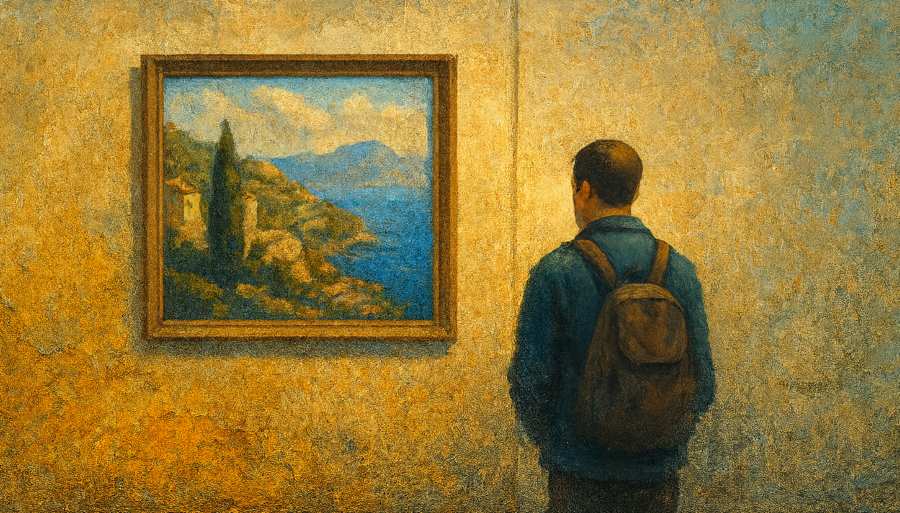Scout the Mood Before the Monument
Rush to the postcard viewpoint and you’ll get a perfect picture that looks mysteriously like everyone else’s perfect picture. Linger by a bus stop and you’ll collect weathered hands, scuffed shoes, the choreography of boredom. These details carry a city’s pulse. Pace a block and ask: is the place brisk or unhurried, hushed or chatty, polished or scuffed? Frame the answer, not the brochure.If you’re unsure where the mood gathers, follow small sounds—the clack of cups, a bicycle’s bell, a gate complaining on its hinges. Sound leads to gesture; gesture leads to narrative. Photographs transported into hotel spaces benefit from this quiet anthropology. A viewer doesn’t need a caption to feel the coffee was strong or the queue was existential.
- Start wide, then narrow: make a context shot, then close in on one telling fragment.
- Watch for micro-theatre: nods, shrugs, shared eye-rolls at an obstinate vending machine.
- Wait one extra beat after the “obvious” shot; the unscripted bit usually arrives late.
Let Texture Outvote Skyline
A wall, properly considered, can be a biography. Flaked paint confesses to summers that overstayed. Tiles speak of municipal optimism. Stone worn to a shallow bowl remembers thousands of purposeful feet. Photographing these surfaces is not decorative; it’s documentary. For hotel art, texture anchors the room, giving the eye something to explore at the speed of thought rather than the speed of a tour bus.Work with grazing light—early or late—so every nick and ridge casts a gentle shadow. Step sideways instead of closer; angle matters more than millimetres. A shallow depth of field isn’t a magic wand. Use it when the background distracts, not as a default. Sharp where the story lives is the rule: the fingerprint in wet cement, the seam in old leather, the scratch that reveals a previous colour beneath today’s façade.
Serious note: avoid exoticising decay. A peeling door is not your prop. Context dignifies it—include the careful sweep marks below, the repaired latch, the fresh plant on the stoop. You’re showing endurance, not ruin.
Chasing the Ghost of Atmosphere
Atmosphere is a slippery accomplice. You can’t ask it to pose, and it refuses to sign a release form. It lives in the interaction between subject and air—the haze over a harbour, the sigh of steam from a food stall, the colour of laughter when the sun drops behind an unfamiliar skyline. Travel photography that captures atmosphere isn’t about what’s in front of the lens, but how the air between you and it feels.This is where patience outperforms equipment. Wait for weather to misbehave. Mist, drizzle, or dust will do more for the mood than a new camera body ever will. Set up, breathe, and let the elements smudge the truth a little. Perfection is sterile; atmosphere thrives on minor chaos.
Hotels that hang such work know what they’re doing. Guests don’t want to stare at a landmark; they want to feel momentarily located inside a lived story. A street corner with uncertain light can suggest more restfulness than any horizon could promise. The image becomes a conversation piece that doesn’t speak too loudly.
Gesture Over Grandeur
Human presence—sometimes only hinted at—anchors the emotional tone of place. A lone figure adjusting an umbrella, a market vendor resting his chin on folded arms, the blur of a cyclist escaping the frame: these gestures compress entire novels into a fraction of a second. They are small truths, and small truths are portable; they travel well across cultures and hang well above beds.Avoid the temptation to make strangers perform authenticity. Observe; don’t stage. The world doesn’t need another grinning artisan brandishing a tool for your lens. Authentic gestures occur at the edge of indifference—when people forget they’re being seen. A respectful distance, a lens that listens, and the humility to stay unremarked upon: that’s the recipe for photographs with pulse.
Editing for Emotion
Back at your desk—or hotel desk if you’re still pretending to be on holiday—remember that editing is emotional triage. Discard what’s merely impressive. Keep what feels inhabited. Don’t over-saturate; the world isn’t made of cinema posters. Colour should behave like seasoning, not a sauce.Convert to black and white sparingly and with intent. Monochrome doesn’t make things deep; it simply strips away the evidence of time. Sometimes that works, sometimes it’s vandalism. Test both. When you find the image that hums quietly to itself, you’ll know.
Room With a Viewfinder
Hotel art, at its best, is not decorative wallpaper but ambient storytelling. A strong travel photograph invites a kind of calm curiosity—it doesn’t instruct, it seduces. The viewer feels not that they’ve *been* somewhere, but that they *might have been*, once, perhaps in a dream that smelled faintly of espresso and jet fuel.When curating such images for interiors, consider emotional climate: soft greys for contemplation, gentle contrast for subtle optimism. Avoid bombast. A sunset screaming across the wall is less relaxing than it sounds. Let the print breathe; let the space take part in the conversation.
Developing a Sense of Place (and Humility)
Travel photography isn’t about owning the view; it’s about being briefly tolerated by it. The most affecting images are souvenirs of permission. You were allowed to look, just once, and you looked well. That’s what resonates in the corridors of hotels or the quiet walls of homes far from where the shutter fell.Every click of the camera is a small negotiation with the soul of a place. Sometimes the soul refuses, and you get nothing. Sometimes it offers a crumb of truth—a reflection, a gesture, a half-lit doorway—and that’s enough. Frame it, print it, and let someone else wake up beneath it, wondering why the air in that picture feels so familiar.
Article kindly provided by davidsmith520photography.com
